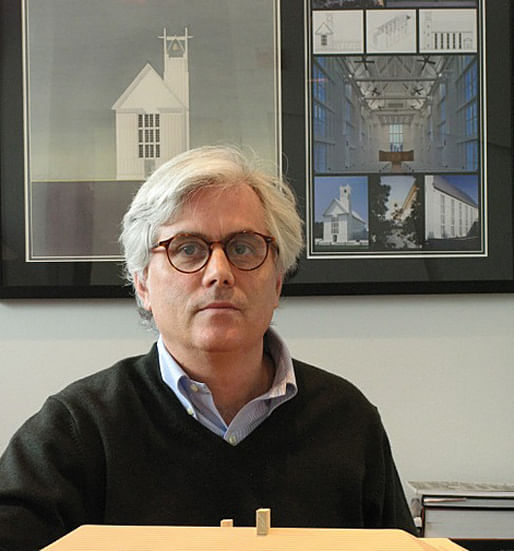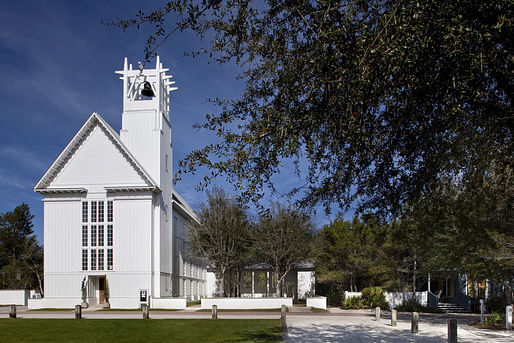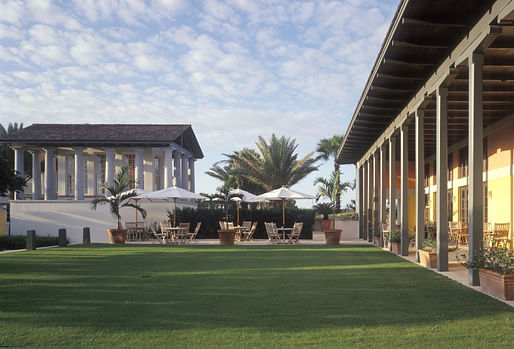

Scott Merrill, an architect known for his originality and creative application of architectural precedents, has been named the recipient of the 2016 Richard H. Driehaus Prize at the University of Notre Dame. Merrill, the 14th Driehaus Prize laureate, will be awarded the $200,000 prize and a bronze miniature of the Choregic Monument of Lysikrates during a ceremony on March 19 (Saturday) in Chicago. — University of Notre Dame School of Architecture

Scott Merril, the founder and principal designer of Merrill, Pastor & Colgan in Vero Beach Florida, has been awarded the 2016 Richard H. Driehaus Prize at the University of Notre Dame.
Now in it's 14th year, the Driehaus Prize is something like an alternative Pritzker awarded to "a living architect whose work embodies the highest ideals of traditional and classical architecture in contemporary society, and creates a positive cultural, environmental, and artistic impact."

Initiated by the fund manager and philanthropist Richard Driehaus, the Prize comes with a $200,000 check – about double the amount awarded with the Pritzker.
"The jury’s selection of Scott Merrill as the 2016 Driehaus Prize laureate brings into focus his remarkable ability to apply the principles of traditional architecture to a wide variety of building types while integrating unique regional identities,” Driehaus stated in the award announcement. “His work beautifully demonstrates the inherent versatility of traditional architecture.”

Merrill is known for the Seaside Interfaith Chapel in the New Urbanist community of Seaside, Florida, among other public and private buildings. He graduated from the University of Virginia and later Yale School of Architecture.
In the announcement, Michael Lykoudis, the current chair the jury and Dean of Notre Dame's School of Architecture, stated, "Scott Merrill has demonstrated how the principles of classicism can be used as a foundation for designing buildings that respond to and express regional character while employing the richness of precedents found throughout the ages, including our own.

“His applications of architectural forms from various times and places to modern settings are used to reinforce the values of community, beauty and sustainability without sacrificing economy.”
Last year, the Driehaus Prize went to David M. Schwarz. Past recipients have included Michael Graves, Robert A. M. Stern, and Leon Krier.

36 Comments
Well deserved. He's really accomplished, with an incredible body of work.
boring prize for boring work
been to Seaside many times....the church is nice....but my favorite area on 30A? is Alice Beach.......that prize money is doubke the Pritzker?
chigurh - to each his own, but scott's an amazingly erudite architect. that he chooses to work within a narrower framework of "invention" shouldn't lessen his abilities.
I like the scale, not the traditional elements.
Scott has designed some wonderful new mixed-use buildings for Alys Beach which will soon be built.
interesting and thank you for spelling Alys Beach correctly. For those who say, bah humbug to traditional you should compare Alys Beach buildings to the supposed "modern" or "contemporary" montrosity across the highway, from Alys beach, which may actually be done by now and visible via google earth.
across from Alys Beach http://30arealestatesearch.com/hilton-residence-paradise-by-the-sea/
technically Arthur Dyson designed Hilton Residence across from Alys Beach is "organic". i will take traditional and classic over organic any day....
"that he chooses to work within a narrower framework of "invention" shouldn't lessen his abilities."
I wonder if you would say the same thing about a modernist.
modernism is a style with equal amount of potential invention as traditional.
I am not interested in classical architecture because it is a form of high level mimicry. I'm sure this guy is very smart and technically savvy but he using those skills to replicate something that has already been done in the past in some form many times. If your jumping off point for a project is to open a classical history book and emulate all of the stylistic and formal attributes of historical built work that is just boring, especially when we live in a time when you can invent whatever you want - investigate your own style and develop it through a practice that lasts a lifetime. It is counter to the milieu of our time and seems like the path of a person without creative or inventive ambitions - or 'voice' for lack of a better word.
chigurh i am not buying it. modernism is so 1930's and refined out the ass. Frank Gehry and Zaha have shown, for example, that anything is possible. invention does not happen at form and function anymore. its happens at details and technical aspects. in short - there is less invention within style of form than every other aspect of architecture.
The visual results speak for themselves - If you are taking about the guts of a building the only people that know they are the same are other architects.
His work is beautiful. I don't think it is direct copying (mimicry) of things that have been done before at all; it's subtle manipulations of forms rooted in constructability, handled with careful attention to scale, proportion, and material. It's fantastic.
I also like that Dyson house. Why not both?
Some guys like skinny chicks, some like fat chicks, some prefer older women.
If form is all you see when you look at architecture, you need to go back to school.
There is a big difference between duplication and imitation.
"You can never really copy anything in life. Each time you go to the river, you never collect the same water."
- Demetri Porphyrios
As you said, everybody has stylistic predispositions. I consider all aspects of anatomy and kinesiology of women before deciding if they are attractive to me. Can't rely on your instinct on something like that.
^Chigurh, Do you have a checklist or something? A judgement of character is just as instinctive as one of looks.
His buildings are most definitely modern in the ordinary sense - he works largely in the vernacular of current US suburban architecture. Which a lot of architects are conditioned to despise. But the best ones are inventive and memorable. That they are also cute is apparantly a turn off to some, which is silly.
"That they are also cute is apparantly a turn off to some, which is silly."
I agree. I don't think his work is "cute" per se but I understand that comment to mean it aims to please someone that might not have received a formal education in architecture. As for mimicry, one reason it's applied to traditionalists isn't that they are a breed apart from modernists, but that the language they employ is more recognizable and therefore similarities in patterns become more conspicuous. This is how traditions are in fact carried forward, assuming one thinks that is a good thing.
Like relations with each other, we all like the wild and crazy person, but we also like consistency in people we associate with. This is something many who champion constant novelty forget, that like it or not, we exist in a larger continuum of time and traditions help ground us in an ever changing environment. It's not about constricting ourselves as much as putting us in a wider social construct through a shared language and traditions.
I think the guy has well executed and detailed work - I just think the conceptual approach is boring: look at historical work - execute some variation of that work in a contemporary tectonic. Wouldn't be rewarding to me on a personal level. Think there is something to be said about the tabula rasa as stepping off point - the unknown and the creative process associated without following a "guide" to get to an end result. Need to have a tolerance for ambiguity to work in the latter.
chigurh, that's a valid and well-articulated viewpoint. It reminds me of when we talked about parametricism on the podcast; I can't recall whether it was the actual conversation with Patrik Schumacher or an earlier one talking about a news item. Schumacher had said (I'm deeply oversimplifying) that they feed in inputs and parametrics brought out a form, *but* when that form ended up too closely resembling something known, like a fish or a bucket or a lollipop, they tweaked the inputs to get a form that they like better. So there is always some sounding board of known forms that humans will intuitively compare buildings to.
It also reminds me of this awesome non-building that is a gorgeous piece of architecture, in my mind.

The tabula rasa was one of the founding principles of modernism. Unfortunately, it's as nonsensical as thinking we can learn to read and write without mimicry. Not that there isn't merit in the spirit of the phrase, but it's simply unattainable in the world of humans. Even Johnson and Hitchcock debased the idea in their seminal book, International Style, which introduced modernism to the United States. Everybody is attracted to the forms they are, for what ever reason, and to execute what they like well, they study similar forms. All this sophistry does is breed cynicism.
These no such thing as classical or modern. There is only buildings. Nice work!
Aesthetically, the Seaside Chapel stands out as a solid work, as does Rosemary Beach Town Hall. But the housing is horrendous, especially the single family. Some of the work, like that Parthenon knock-off, is utterly pretentious. Overall it looks well-crafted, but largely not to my taste.
Miles...could you show an example of some of Merrill's housing you think is horrendous, and explain why you think it is? Genuinely interested in understanding your critique.
modernism is mimicked a lot by modernists, hence my played out since 1930 statement. this is an architect award so "we" architects can discern good work within a language and its great if lay people like it as well.
Ill-proportioned, repetitious, grandiose. Humongous boxes unrelated to the site, loaded with psudeoclassical / quasi-traditional details. To be honest it's as much a rejection of the clientele as it is of the architecture. It's architecture for the stupid.
what was that long ass eisenman essay title again? the beginning of the end, the end of the beginning.....modernism is tradionalism or something like that.
miles - seriously? i can't see that in all of them for sure. the honeymoon cottages at seaside (whatever you think of them aesthetically) are wonderfully scaled, small structures (700sf or so each) that absolutely respected the site. i'm assuming you'd dismiss mckim mead white's large shingle house (the low house) for all the same reasons above, right?
thayer - sorry i missed your comment earlier. yes, i think you can absolutely say that about a modernist. caruso st. john is unabashedly "modern" but looks to narrow the parameters of invention enough* (or at least they did early on) to then expand it back out through smaller scales.
*(can't say that about some of their more recent, larger scale projects that are attempting more formal novelty in the form making itself).
Gregory, seriously.
Seaside cottages are vacation rentals, not housing.
"cottages"..Ha! Thats just rich people bullshit.
I spoke with Scott for our next One-to-One podcast interview, out Monday. He was candid, modest about what he does in general, and had some thoughts about the profession that I don't often hear – and personally, I'm really interested to see whether his interview affects this comment thread.
Amelia, wonderful interview!
Thanks Thayer-D!
Block this user
Are you sure you want to block this user and hide all related comments throughout the site?
Archinect
This is your first comment on Archinect. Your comment will be visible once approved.